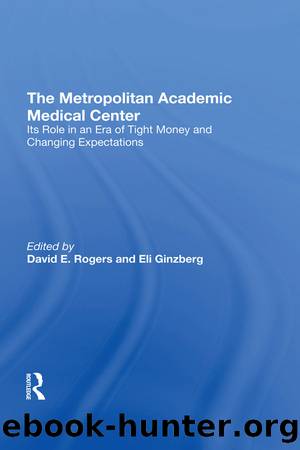The Metropolitan Academic Medical Center by David E. Rogers Eli Ginzberg

Author:David E. Rogers, Eli Ginzberg [David E. Rogers, Eli Ginzberg]
Language: eng
Format: epub
ISBN: 9780367293826
Google: ObeJzQEACAAJ
Barnesnoble:
Goodreads: 53398157
Publisher: Routledge
Published: 2020-06-30T00:00:00+00:00
Source: Parkland Memorial Hospital. R 4.93
Figure 6.4 AIDS Patients, Parkland Memorial Hospital, 1989-I992
Source: Parkland Memorial Hospital. R 4.93
The greatest growth, however, occurred in the outpatient clinic (a subspecialty-oriented academic model of nearly 150 clinics), walk-in clinic (the ambulatory care facility for adults), and primary pediatric care clinic for children with nonemergent acute care problems. Pediatric emergency care is provided to indigent children via a contract between Parkland and Childrenâs Medical Center of Dallas, an adjacent nonprofit hospital partner.
Figure 6.5 demonstrates the growth in out-patient clinic visits, which have extended hours to better serve the working poor and decongest the emergency room. Combined with the addition of available community primary care in the community-oriented primary care (COPC) settings in 1989, ED visits fell from 186,000 to 122,000 over the course of the 1980s.
The sheer volume of ambulatory visits placed additional stress on all hospital systems, creating long lines at the pharmacy, eligibility interview stations, laboratory, and so on, as well as lengthy intervals for appointments for patients referred from the ED or ambulatory care clinic to acute subspecialty clinics. The situation was nearly equivalent to rationing.
The economic recession in Dallas resulted in a large shift from private to publicly supported care. The number of indigent persons in Dallas County had increased from roughly 250,000 to 350,000 over this period. We estimate that Parkland served fewer than 200,000 unduplicated persons each year, further indicating the possibility of enormous underservice. Perhaps some individuals were receiving care elsewhere, but the advanced stages of illness they often presented with would suggest that they indeed lacked comprehensive preventive services and access to primary care other than episodic visits to the ED, private physicians, or community clinics.
At the same time that these volumes were increasing, the tax base for Dallas County was declining, requiring higher tax rates to generate the same number of dollars (Figure 6.6). Local support for further increases in taxes to fund public schools, county or city governments, and the hospital district was becoming less evident. Increased Medicaid funding and stable county tax support provided roughly $150 million of Parklandâs $400 million budget, and additional revenues derived from centers of excellence. In this way, the hospital progressively decreased its dependence on local taxes (Figure 6.7).
It was clear that Parkland was stuck on both horns of the dilemma. We had stable to declining local tax support and increasing volumes of mandated care. We also knew from the burden of patient illness at presentation and the underservice in the community that the involutional academic model (highly centralized and subspecialized) could not adequately address these needs.
Further, as an academic institution, Parkland Memorial Hospital was interested in contributing to the improvement and expansion of primary care and public health to achieve healthier communities. We named the academic component of COPC âCommunity Responsive Medicine.â3,4
Training and relevant health services research in community medicine and primary care are sorely needed on both a national and local basis.5,6
Figure 6.5 Outpatient Clinic Visits, Parkland Memorial Hospital, 1982â1992
Download
This site does not store any files on its server. We only index and link to content provided by other sites. Please contact the content providers to delete copyright contents if any and email us, we'll remove relevant links or contents immediately.
How Data Happened by Unknown(167)
Introduction to Social Work Practice : A Practical Workbook by Herschel Knapp(144)
Global Health Governance and Commercialisation of Public Health in India by Anuj Kapilashrami Rama V. Baru(109)
Curing Cancerphobia by David Ropeik(80)
Feminist Global Health Security by Clare Wenham(79)
Restoring Quality Health Care by Scott W. Atlas(72)
Risk Communication and Infectious Diseases in an Age of Digital Media by Anat Gesser-Edelsburg Yaffa Shir-Raz(67)
The Pandemic Divide by Gwendolyn L. Wright Lucas Hubbard and William A. Darity Jr(66)
Transforming Health Care Scheduling and Access: Getting to Now by Gary Kaplan(65)
Insane Society: A Sociology of Mental Health by Peter Morrall(64)
Oversight and Review of Clinical Gene Transfer Protocols: Assessing the Role of the Recombinant DNA Advisory Committee by Rebecca N. Koehler(64)
Into Africa, Out of Academia by Kwan Kew Lai(61)
Social Work in a Glocalised World by Mona Livholts Lia Bryant(61)
FALSE PANDEMICS: ARGUMENTS AGAINST THE RULE OF FEAR by Wolfgang Wodarg(61)
Pandemic India by Arnold David;(59)
The Metropolitan Academic Medical Center by David E. Rogers Eli Ginzberg(55)
Psychosocial Interventions for Mental and Substance Use Disorders: A Framework for Establishing Evidence-Based Standards by Mary Jane England(54)
World Health Systems by Sun Xiaoming;(48)
A Hospital for Ashe County by Janet C. Pittard(45)
